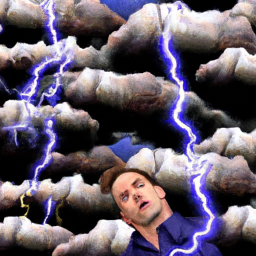It is fascinating how some days we wake up and can vividly recall every detail of our dreams, while on other days we struggle to remember even a single scene.
I’ve always been fascinated by the mystery of dreams and what they can tell us about ourselves.
Recently, I stumbled upon an interesting fact that there are three types of dreams: normal dreams, lucid dreams, and nightmares.
Coincidentally, I had just woken up from a vivid dream that left me feeling uneasy.
It got me thinking about the different types of dreams and how they can impact our mood and daily life.
So, I decided to do some research and learn more about each type of dream and what they reveal about our subconscious.
Join me as we delve into the fascinating world of dreaming and explore the three types of dreams.
Key Takeaways
- The three types of dreams are normal dreams, lucid dreams, and nightmares.
- Dreams can be influenced by various factors such as sleep disorders, medication, and certain foods.
- Dreaming plays a crucial role in memory consolidation, problem-solving, and emotional regulation.
- Interpretation and meaning of dreams are subjective and personal experiences that can provide valuable insights into innermost thoughts and emotions. Understanding symbolism and messages can help make sense of life, and keeping a dream journal and reflecting on symbols and emotions can help gain better understanding of unconscious desires.
Normal Dreams
You’re laying in bed, relaxed and drifting off into a peaceful slumber, when suddenly you find yourself soaring through the sky in a world where anything is possible – this is a normal dream.
Normal dreams are the most common type of dream and are often a reflection of our daily experiences, thoughts, and emotions. In a normal dream, we’re not aware that we’re dreaming and we’re unable to control the events that take place within it.
Normal dreams can range from mundane to bizarre, and they can be influenced by a variety of factors such as our mood, health, and environment. For example, if we’re anxious or stressed, we may have nightmares that reflect those emotions. Similarly, if we’ve recently watched a scary movie, we may have a dream that’s influenced by that experience.
However, regardless of the content of the dream, normal dreams are an important part of the sleep cycle and can provide insight into our subconscious thoughts and feelings.
Speaking of dreams, have you ever heard of lucid dreams?
Lucid Dreams
When you’re in a lucid dream, it’s almost like being in a virtual reality game where you can control the environment and your actions. It’s a fascinating experience that many people strive to achieve.
In a lucid dream, you become aware that you’re dreaming and can then steer the dream in any direction you desire. You can fly, teleport to different locations, and even alter the people and objects around you.
Lucid dreams can be exhilarating, but they can also be terrifying. Sometimes, a dreamer may accidentally turn a pleasant dream into a nightmare by losing control of their thoughts and emotions.
Speaking of nightmares, they are the next type of dream we’ll explore.
Nightmares
Nightmares can be a terrifying experience that can leave a lasting impact on our psyche. I remember having a particularly vivid nightmare as a child that still haunts me to this day. I was being chased by a monster through a dark forest, and no matter how fast I ran, it always seemed to be right behind me. When I woke up, I was drenched in sweat and couldn’t shake the feeling of dread that lingered for hours.
According to a study by the Sleep Foundation, nightmares are most common in children and are often caused by anxiety, stress, or trauma. They can also be triggered by certain medications or medical conditions. In order to better understand the causes and effects of nightmares, let’s take a look at the following table:
| Causes of Nightmares | Effects of Nightmares |
|---|---|
| Anxiety | Fear |
| Stress | Sleep disturbance |
| Trauma | Anxiety |
| Certain medications | Psychological distress |
| Medical conditions | Physical symptoms |
Understanding the root cause of our nightmares can help us mitigate their effects and prevent them from reoccurring. This brings us to the science of dreaming, which delves deeper into the mysteries of our subconscious mind.
The Science of Dreaming
The science of dreaming reveals how our subconscious mind can influence our thoughts and behavior, often coinciding with our emotions and experiences in waking life. As I delve into the world of dreams, I’ve come across three interesting facts about dreaming that have left me in awe:
-
The average person spends about six years of their life dreaming. That’s a lot of time spent in a world that’s entirely different from reality.
-
Dreams can be influenced by a variety of factors such as sleep disorders, medication, and even certain foods. This means that what we eat or how we sleep can impact the content and quality of our dreams.
-
Studies have shown that dreaming plays a crucial role in memory consolidation, problem-solving, and emotional regulation. This means that even if we don’t remember our dreams, they’re still working behind the scenes to help us cope with daily challenges.
As fascinating as the science of dreaming is, it’s important to note that the interpretation and meaning of dreams is a subjective and personal experience.
In the next section, I’ll explore the various ways in which dreams can be interpreted and how they can provide insight into our innermost thoughts and feelings.
Interpretation and Meaning
Exploring the interpretation and meaning of dreams can provide valuable insights into our innermost thoughts and emotions. As a person who’s always been fascinated by the mystery of dreams, I believe that understanding the symbolism and messages behind our dreams can help us make sense of our lives.
While some people believe that dreams are simply random brain activity, others see them as a way for our subconscious to communicate with us. From recurring dreams to nightmares, each dream can hold a deeper meaning if we take the time to analyze it.
By keeping a dream journal and reflecting on the symbols and emotions present in our dreams, we can gain a better understanding of ourselves and our unconscious desires. So next time you wake up from a strange dream, take a moment to reflect on its possible meanings.
You might be surprised by what you discover about yourself.
Frequently Asked Questions
What is the difference between a dream and a daydream?
A dream is a subconscious experience that occurs during sleep, while a daydream is a conscious experience that occurs while awake. Dreams often have deep meanings and can be interpreted, while daydreams are usually just pleasant distractions.
Can dreams predict the future?
Dreams can seem like glimpses into the future, but there’s no scientific evidence that they can predict it. However, there are three types of dreams: lucid, nightmares, and normal dreams, each with their own unique characteristics.
Why do some people have recurring nightmares?
I often have recurring nightmares and wonder why. It turns out they can be caused by stress, trauma, or even certain medications. Talking to a therapist can help identify and address the root cause.
Can lucid dreaming be dangerous?
I once had a lucid dream where I was being chased by a monster, and I tried to fight it but couldn’t. It felt so real that I woke up scared. While lucid dreaming can be exciting, it can also be dangerous if not done properly, leading to sleep paralysis or anxiety. It’s important to approach it with caution and seek guidance if needed.
Is there a way to control the content of our dreams?
Yes, there are ways to control the content of our dreams. Keeping a dream journal and practicing visualization techniques can help shape the direction of our dreams. However, complete control may not always be possible.
Conclusion
As I reflect on the 3 types of dreams, I can’t help but feel in awe of the complexity of our minds. Our ability to dream is a mysterious and fascinating phenomenon that has puzzled scientists for centuries.
From normal dreams to lucid dreams and nightmares, our subconscious mind takes us on a rollercoaster of emotions and experiences that can feel all too real.
Dreams have been described as the window to our soul, a gateway to our deepest desires, fears, and memories. They’re like a canvas on which our imagination paints vivid pictures that can be both beautiful and terrifying.
Like a puzzle waiting to be solved, dreams offer a glimpse into our psyche, revealing hidden messages and meanings that can help us better understand ourselves.
As we continue to explore the science of dreaming, we may unlock the secrets to our own consciousness, and perhaps even discover new ways to harness the power of our minds.










